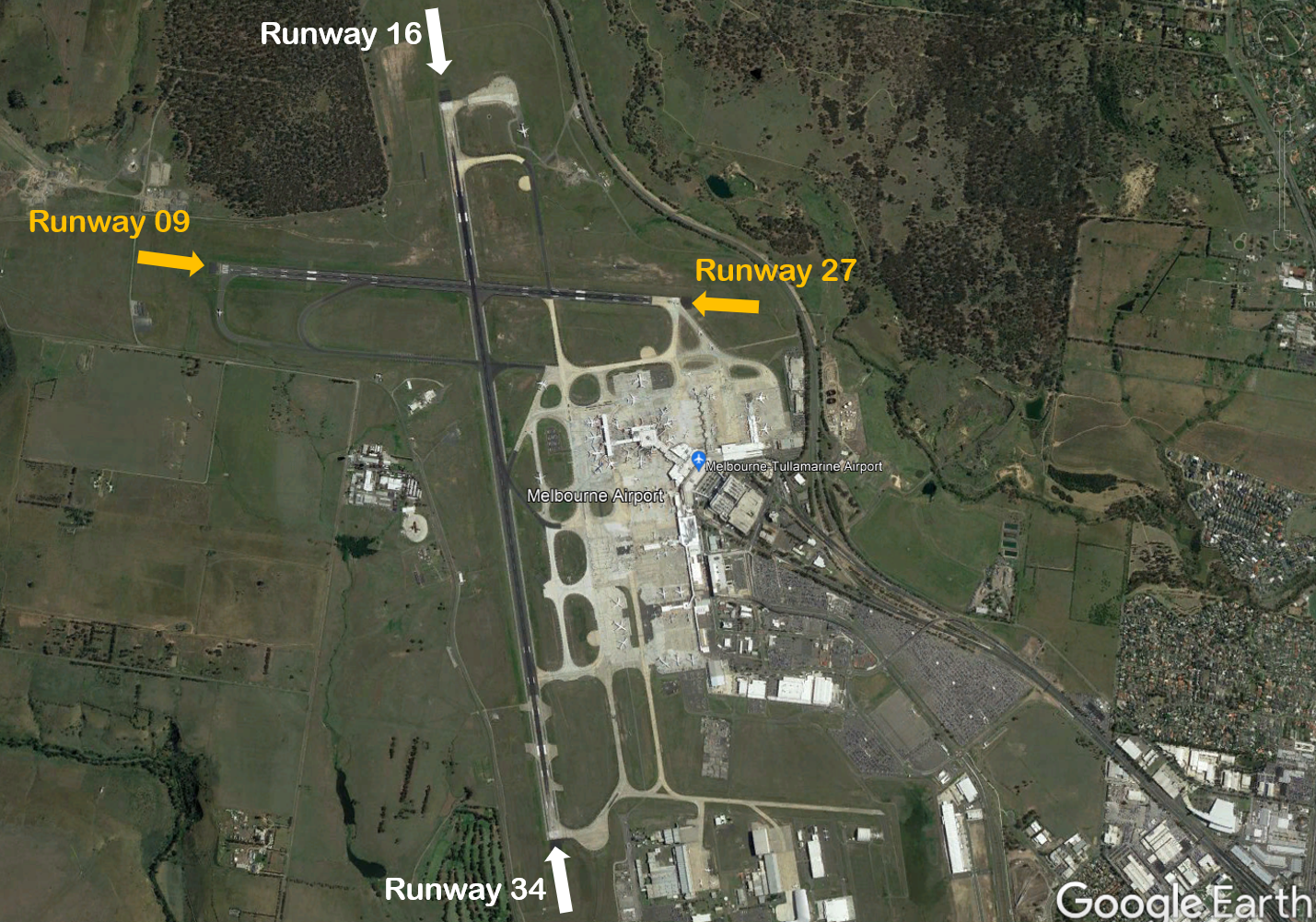Melbourne Airport Runways
Melbourne Airport has two runways; the main runway, Runway 16/34 (3.7 km long) is orientated north-south and the smaller cross runway, Runway 09/27 (2.3km) is orientated east-west.
The main runway is known as Runway 34 when used in a northerly direction and Runway 16 when used in a southerly direction. Runway numbering reflects the runways’ orientation and correlates with degrees on a compass. Runway 34 is 340 degrees.

The following video explains how runways are named and used.
An Instrument Landing System operates for aircraft landing on Runways 16 and 27, and non-precision approaches are available to all runways.
Runway selection and seasonal winds
Runway selection is based on wind direction, weather conditions, traffic volume and other factors. Aircraft primarily take-off and land into the wind for safety and performance reasons. Therefore, as the wind direction changes the runway in operation may also change depending on the strength of the wind.
This means that Melbourne’s seasonal wind patterns affect usage of the different runway directions. Specifically, Runway 16 tends to be used more frequently in the warmer months due to southerly winds whereas Runway 34 tends to be used more frequently in the cooler months when the predominant wind direction tends to be northerly. The pattern of use of Runway 27 tends to be less clear-cut as it can generally be used with either a northerly or southerly wind, provided the crosswind does not exceed the maximum allowed speed of 20 knots, including gusts.
Runways may be used in combination. For example, Runway 27 may be used for departures while Runways 27 and 34 are being used in combination for arrivals.
Noise abatement procedures
Noise abatement procedures are designed to help reduce the impact of aircraft noise on communities. While they are applied whenever it is possible to do so, their use is not mandatory and is subject to weather conditions and traffic requirements. Apart from weather, other operational factors can also necessitate using a particular runway e.g. some large heavy aircraft and long haul flights require the length of the north-south runway to take off or land safely.
The Melbourne Airport Noise Abatement Procedures (NAP) prioritise landings and take-offs over less populated areas to the north and west of the airport whenever possible. The NAP distributes the use of flight paths via the nominated runways to lessen noise intensity over any single area.
The NAP outlines that between 6.00 am and 11.00 pm, when there is not heavy traffic, Runways 16 and 27 are equally preferred for landing. Runway 27 used in combination with Runway 34, and Runway 27 used alone, are equally preferred for departures.
During busy periods between 6.00 am and 11.00 pm, Runways 27 and 34 used in combination and Runways 34 and 09 used in combination are equally preferred.
At night, between 11.00 pm and 6.00 am, the preferred runway for arrivals is Runway 16 and for departures is Runway 27.
Melbourne Airport uses the high capacity landing mode, LAHSO (Land and Hold Short Operations) on Runway 34 during peak periods when wind conditions allow. It is used to increase airport capacity during peak arrival periods when significant airborne delays would otherwise occur. In this mode, aircraft land on runway 34 and exit the runway before the intersection with the east-west runway 09/27, so both runways can be used at the same time with minimal disruption. Pilots may accept a LAHSO clearance provided that the pilot-in-command is approved to use the procedure and has determined the aircraft can safely land and stop within the available landing distance.
When high arrivals demand requires the use of LAHSO, or when wind conditions mean that only one runway can be used due to strong crosswinds, the priority runways will change accordingly.
Melbourne Airport third runway
In September 2024, the federal government approved the Major Development Plan (MDP) for the construction of the third runway at Melbourne Airport.
Melbourne Airport conducted public exhibition of the MDP from February to May 2022, giving the community an opportunity to provide feedback and utilise an interactive noise tool to explore future aircraft tracks. The proposal included detailed planning documents and considered the project’s impact on the community.
The MDP approval is subject to certain conditions on Melbourne Airport including:
- design and implementation of a Noise Sharing and Airspace Concept Plan that prioritises sharing of aircraft noise between affected areas
- maintaining sufficient capacity on the existing east-west runway to support noise sharing
- implementation of a noise amelioration program to communities most impacted
- conducting a community health study into the impacts of noise before and after the establishment of the third runway
We expect that the operation of the third runway will result in aircraft noise decreasing in some areas and increasing in others. Further community engagement will be undertaken by both Airservices Australia and Melbourne Airport throughout the flight path design process.
For more information on the third runway and upcoming consultation opportunities, please visit the Melbourne Airport website.



